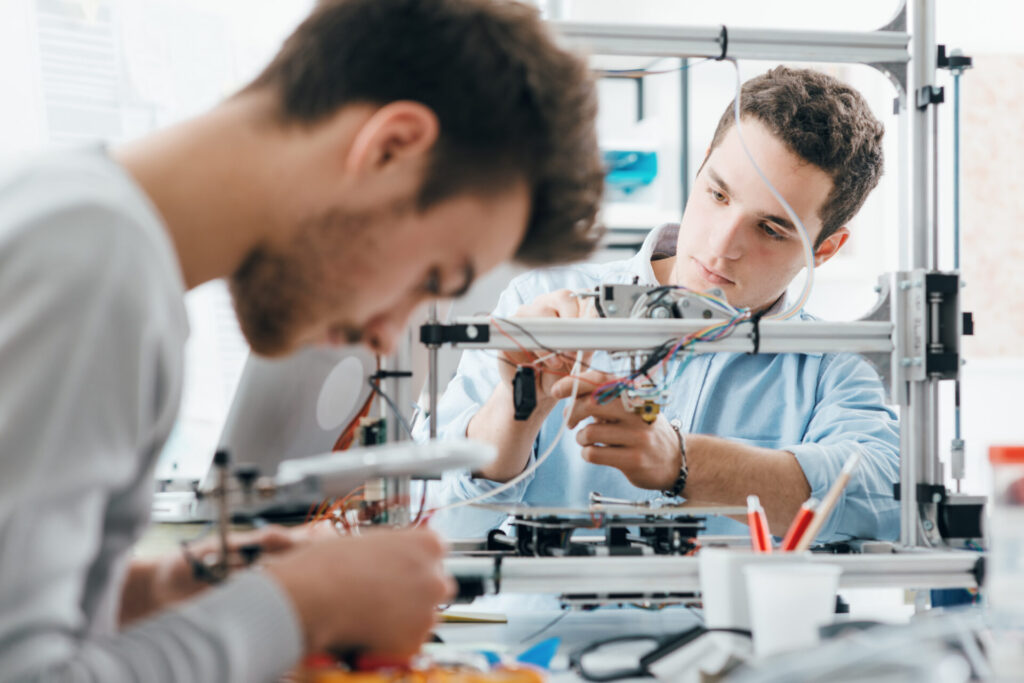& Construction

Integrated BIM tools, including Revit, AutoCAD, and Civil 3D
& Manufacturing

Professional CAD/CAM tools built on Inventor and AutoCAD
8 min read
In education, 3D printing, supported by tools like Autodesk Fusion, enhances learning by making complex concepts tangible, fostering creativity, and preparing students for future careers.
3D printing, also known as additive manufacturing, is a production technique that creates three-dimensional objects from computer-aided design (CAD) files. This process involves depositing materials—typically plastics, metals, wax, or composites—layer by layer to build a shape. The entire procedure is controlled by a computer. Thus, making 3D printing a cost-effective, efficient, and accurate method to create objects of almost any geometry or complexity.
Today, 3D printing is widely used across various industries to produce prototypes, tools, jigs, components, and end-use parts. 3D printers come in various sizes, ranging from compact models that fit on a benchtop to large-format industrial machines. While larger printers can produce bigger objects, they require more space and are more expensive than benchtop printers. Additionally, achieving a successful print with a large-format printer can be more complex due to the increased volume of material and extended printing time involved.

3D printing is revolutionizing education by making complex subjects more accessible and engaging for students. This technology allows learners to bring theoretical concepts to life by creating tangible, three-dimensional models of their ideas. For example, students can print anatomical models for biology, historical artifacts for history, and geometric shapes for mathematics, enhancing their understanding through hands-on experience. This interactive approach not only makes learning more enjoyable but also helps students grasp difficult concepts more easily. 3D printing also encourages creativity and innovation. Students can design, prototype, and refine their projects, fostering critical thinking and problem-solving skills.
Furthermore, 3D printing prepares students for the future workplace by familiarizing them with modern manufacturing processes and digital design tools. Programs like Autodesk Fusion integrate seamlessly with 3D printing, offering a comprehensive platform for design, engineering, and manufacturing. This real-world application of technology equips students with valuable skills that are highly sought after in various industries. These range from engineering and architecture to healthcare and product design. By incorporating 3D printing into the curriculum, educational institutions can provide students with a competitive edge. Ultimately, this makes them more adept at tackling future challenges and opportunities in a rapidly evolving technological landscape.
3D printing in education fosters the development of a wide range of valuable skills that are crucial for students’ academic and professional growth. One of the primary skills enhanced through 3D printing is design and creativity. Students are encouraged to think outside the box and bring their innovative ideas to life by designing unique, three-dimensional objects. This process involves using computer-aided design (CAD) software, which improves their computer literacy and proficiency with digital design tools. Additionally, students gain hands-on experience with 3D modeling, enabling them to understand the intricacies of translating a digital model into a physical object.
Moreover, 3D printing cultivates problem-solving and critical-thinking skills. As students design and print their projects, they often encounter challenges that require them to troubleshoot and iterate on their designs. This iterative process teaches persistence and the importance of learning from failures to achieve success. Collaboration and teamwork are also emphasized, as students frequently work in groups to complete projects, enhancing their communication skills and ability to work effectively with others. Furthermore, exposure to science, technology, engineering, and mathematics (STEM) concepts through 3D printing projects helps students develop a solid foundation in these fields, preparing them for future careers in technology-driven industries. Overall, 3D printing in education equips students with a versatile skill set for navigating the complexities of the modern world.
Teaching aids and models
3D printing is widely used to create ultra-realistic and accurate models that help explain complex concepts. For instance, anatomical models for biology classes, historical artifacts for history lessons, geometric shapes for mathematics, and chemical compounds for chemistry are just a few examples. These tangible aids make abstract or difficult-to-understand topics more accessible and engaging for students.
Prototyping and product design
Students can design, prototype, and refine products using 3D printing. This application is particularly beneficial in engineering, business studies, and design courses, where students can turn theoretical ideas into tangible products. They can test their designs, make improvements, and produce final working models. Thus, gaining hands-on experience in product development and iterative design processes.
Customizable learning tools
3D printing allows educators to create customized educational tools tailored to individual learning needs. For example, teachers can produce custom puzzles, manipulatives, and interactive learning aids that cater to different learning styles and abilities. This customization makes learning more inclusive and effective, particularly for students with special educational needs.
STEM education projects
3D printing is integral to many STEM (Science, Technology, Engineering, and Mathematics) projects. Students can design and print components for robotics, physics experiments, and engineering challenges. This hands-on approach not only reinforces theoretical knowledge but also enhances practical skills. It also fosters a deeper understanding of STEM subjects through experiential learning.
Art and design
In art and design education, 3D printing opens up new avenues for creativity and expression. Students can create intricate sculptures, jewelry, fashion accessories, and other art pieces that would be difficult or impossible to produce with traditional methods. This application not only expands the creative possibilities but also introduces students to digital fabrication techniques that are increasingly relevant in contemporary art and design practices.
Autodesk Fusion is a powerful tool that significantly enhances the integration of 3D printing in educational settings. Here are some ways Fusion can transform the educational experience:

One of the primary challenges to the widespread adoption of 3D printing in education is the cost. While there are affordable entry-level 3D printers, the initial investment for quality machines and the ongoing costs for materials and maintenance can be significant. Additionally, specialized printers that can handle advanced materials like metals and composites are much more expensive. Thus inherentely limits their accessibility to higher education institutions and well-funded schools.
Many educators are not familiar with 3D printing technology and may not understand how to integrate it effectively into the curriculum. This lack of knowledge can result in underutilization of the technology or reluctance to adopt it in the first place. Comprehensive training and ongoing professional development are necessary to help teachers gain the skills and confidence needed to incorporate 3D printing into their teaching practices.
Entry-level 3D printers typically print in a limited range of materials, most often plastics like polylactic acid (PLA) and acrylonitrile butadiene styrene (ABS). This restriction can limit the types of projects and experiments that can be carried out. More advanced materials require specialized, more expensive printers and additional safety considerations, which may not be feasible for many educational settings.
3D printers require regular maintenance and troubleshooting. This can be time-consuming and require technical expertise that may not be readily available in all schools. Issues such as clogged nozzles, bed leveling, and software updates can disrupt the learning process and frustrate both teachers and students. Reliable technical support and user-friendly machines are essential to overcoming these challenges.
Integrating 3D printing into the existing curriculum in a meaningful way can be challenging. Educators need to align 3D printing projects with learning objectives and standards, which requires careful planning and curriculum development. Without clear connections to educational goals, 3D printing can be seen as a novelty rather than a valuable educational tool.
Securing funding for 3D printing initiatives can be a challenge, especially in schools with limited budgets. Even when funding is available, it may be difficult to prioritize 3D printing over other pressing needs. Additionally, schools must allocate resources for consumables, software licenses, and potential upgrades, which can strain already tight budgets.
Autodesk Fusion plays a crucial role in addressing the challenges associated with the widespread adoption of 3D printing in education. By offering an integrated, user-friendly platform for design, engineering, and manufacturing, Fusion simplifies the learning curve, making it easier to incorporate 3D printing into the curriculum. This comprehensive suite of tools enables users to create, simulate, and prepare designs for 3D printing all within a single environment, reducing the technical complexities and maintenance issues often associated with multiple software packages.
Additionally, free access aleviates the financial burden and ensures equitable access to advanced design tools. Extensive online resources, tutorials, and community forums support educators in gaining the necessary skills and confidence to effectively use the technology. By bridging the gap between theoretical learning and practical application, Fusion not only enhances STEM education but also prepares students for future careers in a tech-driven world, ultimately making 3D printing more accessible and impactful across diverse educational settings.
The future of 3D printing in education is incredibly promising. It has the potential to transform how students learn and engage with various subjects. As the technology continues to advance, it will become more affordable, user-friendly, and versatile, making it accessible to a broader range of educational institutions.
Enhanced integration with curricula across disciplines will allow students to explore complex concepts in science, technology, engineering, art, and mathematics (STEAM) through hands-on, experiential learning. Emerging trends such as personalized learning paths, where students can tailor their projects to their interests and abilities, will further enhance engagement and retention.
Additionally, the collaboration between educational institutions and industry leaders, like Autodesk, will ensure that students are equipped with cutting-edge skills and knowledge. Ultimately preparing them for future careers in a rapidly evolving technological landscape. With ongoing innovations and increased adoption, 3D printing is set to become a cornerstone of modern education, fostering creativity, critical thinking, and practical problem-solving skills among the next generation of learners.
Are you an educator? Get free access to Autodesk software with the Autodesk Education Plan.
By clicking subscribe, I agree to receive the Fusion newsletter and acknowledge the Autodesk Privacy Statement.
Success!
May we collect and use your data?
Learn more about the Third Party Services we use and our Privacy Statement.May we collect and use your data to tailor your experience?
Explore the benefits of a customized experience by managing your privacy settings for this site or visit our Privacy Statement to learn more about your options.